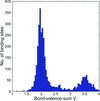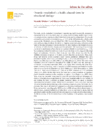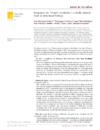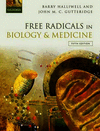issue contents
April 2017 issue

Cover illustration: Hfq is a bacterial Sm protein that regulates mRNA expression and turnover, largely by facilitating the annealing of small noncoding RNAs and their mRNA targets. Two crystal structures of an Hfq homolog from the ancient bacterium Aquifex aeolicus have been determined to 1.5 Å resolution, one in apo form and the other with RNA bound (Stanek et al., p. 294). In the apo form, Hfq crystallized as two hexameric rings stacked in a head-to-tail orientation; as can be seen in this axial view of the dodecamer, the rings are not in perfect rotational register. In this ribbon diagram, the top hexamer is coloured blue and cyan, and Hfq subunits in the bottom hexamer are alternatingly yellow and orange. Molecules of MPD (grey carbons) and GndCl (green carbons) are shown as ball-and-stick representations, and Cl- ions are yellow spheres. The Gnd cations and Cl- anions form a `salty' layer at the ring interface (transverse view in Fig. 5b of the text).
research papers
 access
access access
access access
access access
accessletters to the editor


book reviews




 journal menu
journal menu





























